*TreadmillReviewGuru helps consumers find the best home fitness products. When you buy a product we recommend, we may earn a commission.
Last Updated: February 3, 2020
1. Flat pedals — or clipped pedals:
are the standard flat pedals that work with any athletic shoe. These were originally called “clipped” pedals because of the cage or clip that wraps around the front side of the pedal.
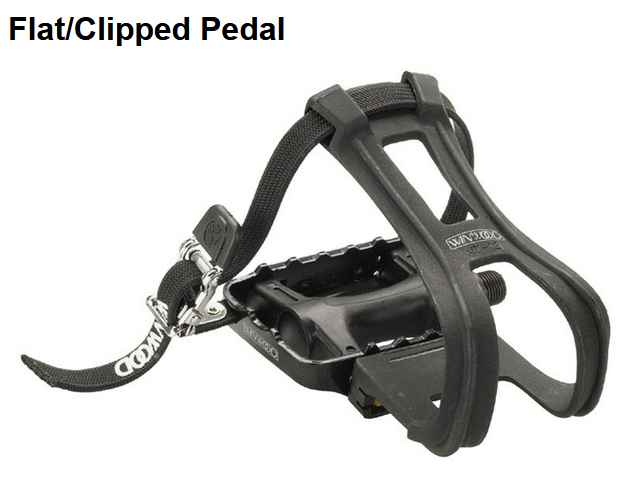
2. Clipless pedals:
are a molded pedal that locks to a cleat on the underside of your cycling shoe. Often, new cyclists think the “clipless” pedals are the flat ones — and “clipped” pedals are the ones you clip into — because that would make sense, right?! Actually, these are clipless pedals:

What are the different kinds of cleats?
Hybrid Flat / SPD Pedals

Hybrid pedals usually have one flat side and one side with an SPD cleat. SPD locks are small and easy to mold on the underside of a flat pedal. (Rarely do you find a hybrid pedal with a SL or LOOK receptor on one side, because the LOOK cleats are very large and require the whole pedal to be molded to hold the cleat.) Hybrid flat/SPD pedals are found on most indoor spin bikes and outdoor mountain bikes. This is our favorite design since they accommodate more shoes and riders.
SPD Pedals (Mountain Bike Pedals)
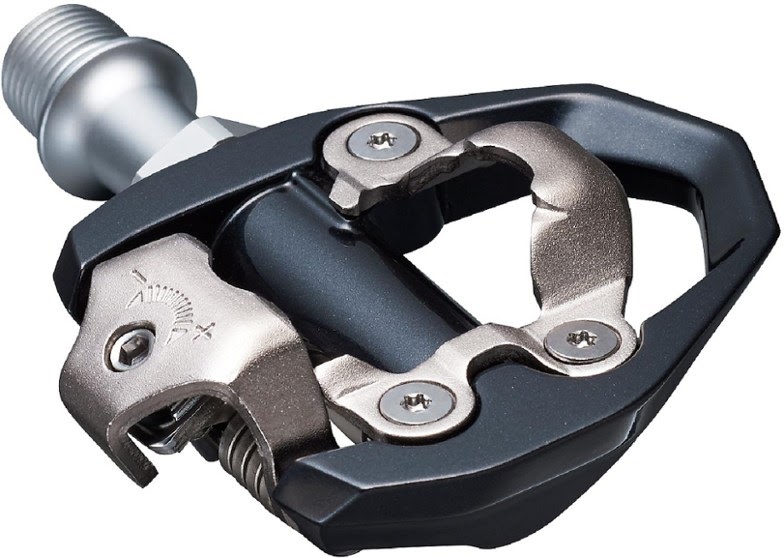
SPD only pedals are typically found on outdoor mountain bikes, but they will also accommodate an SPD spin shoe (seen below). The locking mechanism itself is rather small on the underside of the pedal.
Shoes with SPD Cleats
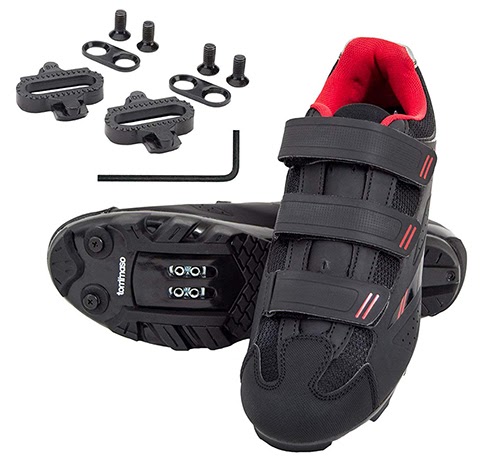
SPD shoes have a cleat that attaches directly under the ball of the foot. The cleat and locking mechanism on the pedal are rather small. The cleat only requires two screws. SPD cleats are easier to lock in and out of, so they work well when mountain bikers have to quickly pull their foot out of the pedal. They are also typically used on indoor bikes since they are easier to get used to and will fit on the underside of a flat pedal.
Delta LOOK/Shimano SPD-SL Pedals (Road Bike Pedals)
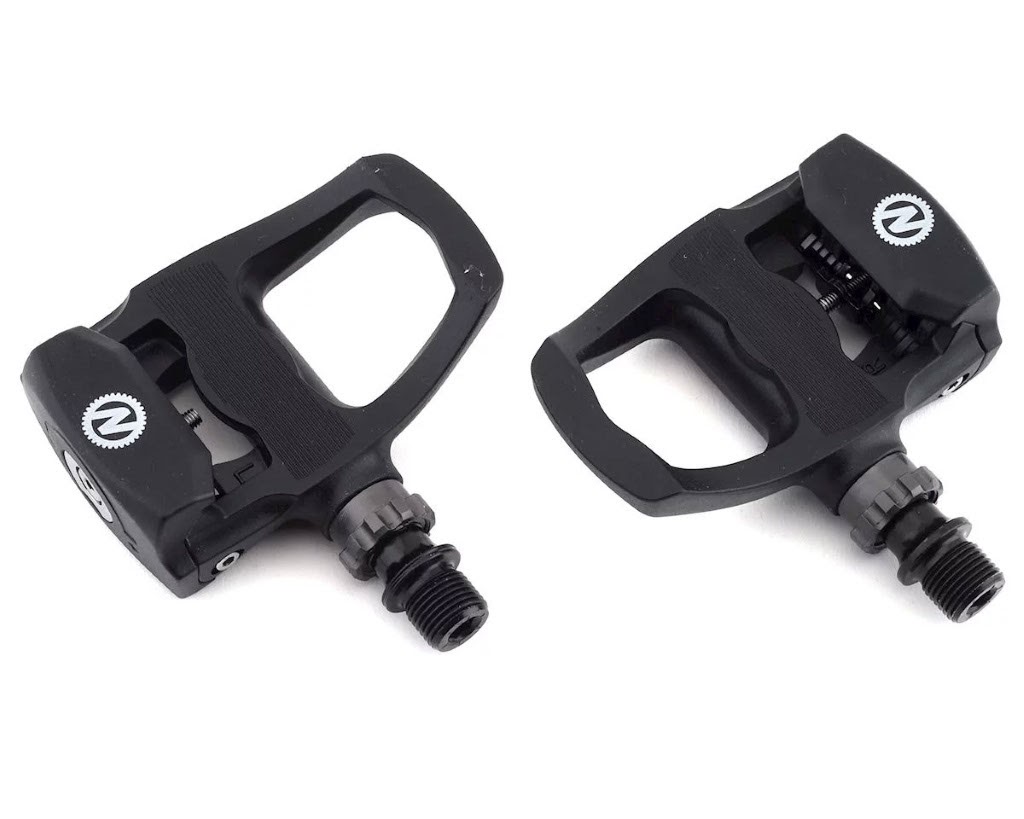
Road bike pedals are designed for larger Delta LOOK or Shimano SL cleats. These pedals are typically molded to the cleat so there is no outer flat area to accommodate an athletic shoe. The only indoor bike that comes standard with Delta LOOK pedals is the Peloton bike.
Shoes with SPD-SL or Delta LOOK cleats
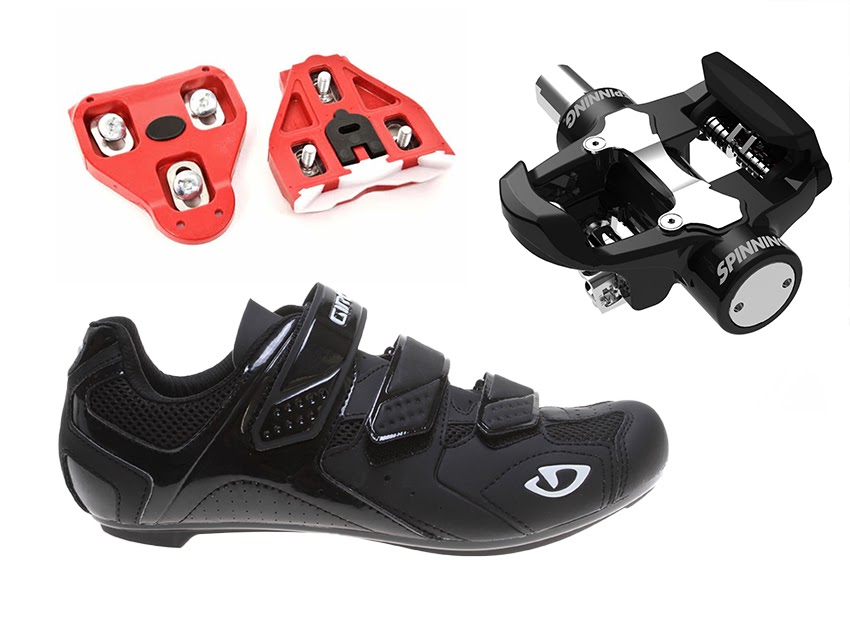
Delta LOOK or Shimano SL cleats are very large and require a proprietary pedal that only supports a cleated cycling shoe. These cleats are larger, cover more of the underside of the shoe, and require three screws. LOOK cleats have greater surface area and provide more support underfoot but they are harder to clip in and out of.
What are the Advantages of Clipping In?
Now that we understand the difference between flat (clipped) pedals and clipless pedals and the kinds of cleats, let’s consider the advantages and disadvantages to using cycling shoes and cleats
Advantages:
-
- Clipping in connects your foot to the pedal, so there is less risk you will lose your footing and have your shoe slip out accidentally. (Shin strikes from a rotating pedal are a real thing and I’ve had people in my spin classes get nasty bruises from a pedal that whacks them in the shin accidentally.)
-
- You are less likely to suffer foot pain or fatigue when riding clipped-in. When you have properly sized cycling shoes and the correct cleat, your foot is locked to the pedal so it doesn’t shift or slip. This reduces arch discomfort and/or foot fatigue from pressing your foot against the pedal.
-
- Cycling shoes with cleats are much stiffer underfoot so they give you more support. Your foot won’t bend around the pedal like it can with soft-soled athletic shoes.
-
- Cycling shoes often fit snugly so you have less risk of blisters or friction spots.
-
- Cycling shoes are only used for cycling, so you don’t have uneven wear patterns that occur from running, walking or aerobics
-
- Clipping in allows you to create force at every point in the pedal rotation. Rather than just press down during the down phase, you can also pull up at the top of the rotation, so you have more power coming over the top end.
-
- Clipping in offsets the quad-heavy motion of emphasizing only the down phase.
-
- Clipping in engages glutes and hamstrings more since these are the muscles used to pull in the upstroke and set up.
-
- You gain more well-rounded and balanced musculature when riding clipped in.
Disadvantages:
-
- Cycling shoes (and cleats) are sold separately. You need to find shoes that fit, and then decide which cleats you want to use. The shoes and cleats can be expensive and add an additional cost.
-
- Certain bikes may come with a specific pedal. You need to make sure you buy the right shoes and cleats for the right pedals. They are not all the same.
-
- If you own a bike that only has clipless pedals, no one can ride the bike unless they own the right size shoes with the right cleats.
-
- Some people may find cycling shoes to be overly restrictive and uncomfortable.
What do we recommend?
Riding clipped in definitely has advantages and once you get used to it, there’s no going back. We prefer hybrid pedals where one side is flat with a cage or strap, and the other has a clip-in option. Most spin bikes in commercial gyms or fitness centers use hybrid pedals with SPD cleats on one side and flat surface on the other. This gives riders the option to use spin shoes or an athletic shoe. If you’ve considered clipping in with cycling shoes, we recommend you try it! We guarantee, in no time at all — you’ll be hooked! (Pun intended)


POST REPLY